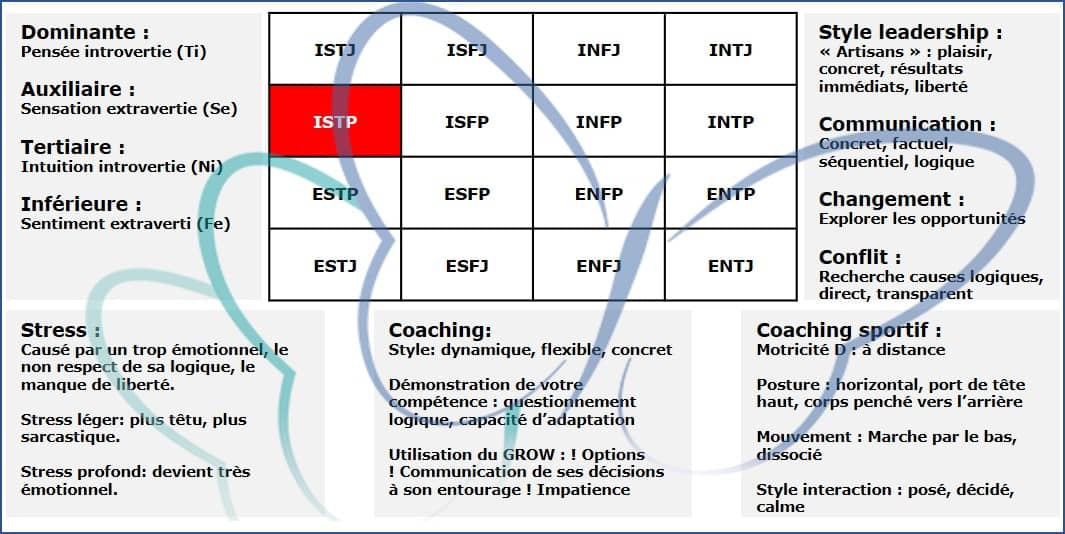Diving into the world of ISTPs is to explore a remarkable alchemy between Introverted Thinking (Ti) and Introverted Intuition (Ni). This duo grants ISTPs a unique ability to analyze and synthesize information with surgical precision. They face challenges with composure and relentless logic while maintaining a subtle overarching vision through their intuition. Discover how this fascinating dynamic evolves over time and how to best guide these virtuosos of rationality in their personal and professional journey.
ISTPs, known for their mechanical mind, primarily rely on their dominant function, Introverted Thinking (Ti), wisely coupled with their Tertiary Introverted Intuition (Ni). This combination forms a powerful cycle often referred to as the Ti-Ni cycle. The latter allows ISTPs to develop a clear overarching vision and precise logical reasoning.
Ti directs ISTPs toward rigorous analysis and a methodical approach to problem-solving. Through it, they dissect complex situations into understandable components, focusing on internal logic. However, without the input of Ni, this analysis could lack a broader perspective. Fortunately, Introverted Intuition intervenes to refine reasoning, enabling ISTPs to formulate long-term strategies and anticipate the consequences of their actions with insight.
For effective coaching of ISTPs, it is crucial to understand this Ti-Ni cycle. The questions posed should target the logic of Ti while stimulating the intuitive vision of Ni. A good coach must encourage the ISTP to channel their analytical talents while exploring new and innovative perspectives, thus fostering a harmonious evolution of their skills.
By understanding and mastering the Ti-Ni cycle, ISTPs can not only improve their personal effectiveness but also respond agilely to complex challenges while maintaining impressive calm in the face of the most demanding situations.

To understand the Ti-Ni cycle of ISTPs, it is essential to grasp the combination of their dominant function, Introverted Thinking (Ti), and their tertiary function, Introverted Intuition (Ni). ISTPs are naturally analytical, using logic to solve concrete problems. Coupled with their tertiary Ni, this gives them a unique ability to see not only the details but also the big picture. This dynamic allows them to excel in technical tasks and projects requiring an overall vision.
The patience of ISTPs, combined with their constant need for improvement, allows them to apply their skills methodically. By learning continuously and maintaining their composure in all situations, they develop a deep and pragmatic understanding of complex systems. The MBTI profile of the ISTP reflects this unique blend of calm and analytical logic, making them often seen as effective and reliable problem solvers.
The dynamics of evolution in ISTPs
Throughout their existence, ISTPs go through different phases of evolution influenced by their Ti-Ni cycle. As they progress in their careers, they develop a better integration of their tertiary function, Introverted Intuition (Ni). This helps them anticipate problems before they arise and envision innovative solutions. MBTI test results often show this growth of the Ni function, which translates into improved strategy and long-term planning.
ISTPs also learn to better manage their stress by optimizing the use of their Ni function. By recognizing early warning signs of stress and anticipating them, they can take preventive actions and avoid repeated stressful situations. To better integrate this dynamic, it is crucial for ISTPs to focus on introspection and regular planning, thus fully exploiting their Ni potential for more balanced and harmonious outcomes.
Coaching an ISTP: effective strategies
For effective coaching of ISTPs, it is essential to adopt an approach based on logic and practice. By asking questions that stimulate their Introverted Thinking (Ti), one can help them clarify their goals and identify logical obstacles to overcome. Integrating practical activities, such as simulations or realistic scenarios, is also beneficial. This allows ISTPs to test their hypotheses and refine their skills tangibly.
Encouraging ISTPs to take regular breaks to reflect and rest is also crucial. As highlighted by this ISTP coaching guide, a simple walk can often suffice to reset their focus and generate new ideas. Providing clear guidelines while offering sufficient leeway for autonomy is key to ensuring their personal and professional growth.

FAQ
Q: How can an ISTP evolve throughout their life?
A: An ISTP evolves by honing their skills and assimilating new knowledge through their patience and practice. The dominant function, Introverted Thinking (Ti), is crucial in this development, with significant support from Introverted Intuition (Ni).
Q: What is the type dynamic for ISTPs?
A: The type dynamic of ISTPs primarily relies on Introverted Thinking (Ti), which analyzes and forms logical judgments, coupled with Introverted Intuition (Ni), which provides an overarching vision and strategic insights.
Q: How does an ISTP react under stress?
A: When stressed, ISTPs may react negatively to strict directives, lack of autonomy, and extremely extraverted activities. They may become impatient in the face of disregard for their personal approach.
Q: How to coach an ISTP?
A: Coaching an ISTP should focus on logical and analytical questions that address their Introverted Thinking (Ti). They should be encouraged to use their logic to solve problems and to channel their Introverted Intuition (Ni) to develop their long-term vision.
Q: How to communicate with an ISTP?
A: For effective communication with an ISTP, use clear, concise, and logical language. Avoid overly emotional or abstract topics and respect their need for autonomy and independence.
Q: What are ISTPs like in love?
A: In love, ISTPs are often pragmatic and reserved. They appreciate relationships based on trust and mutual respect. Their calmness and stability make them reliable partners, although they may struggle to express their emotions.
“`











